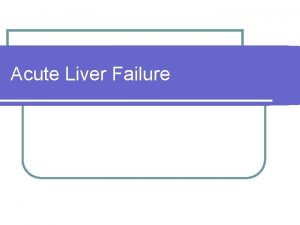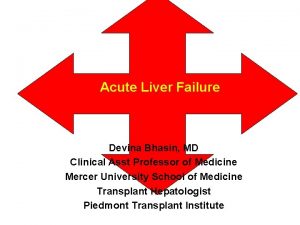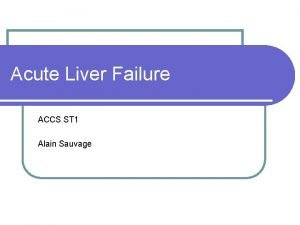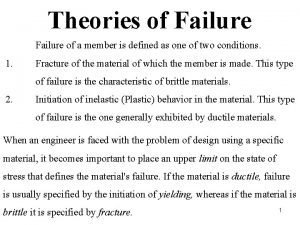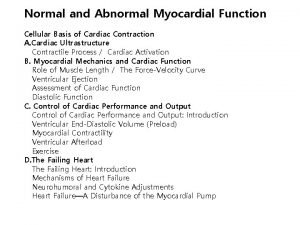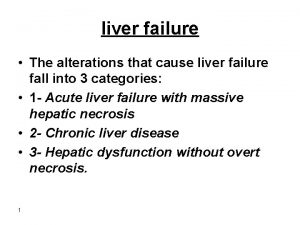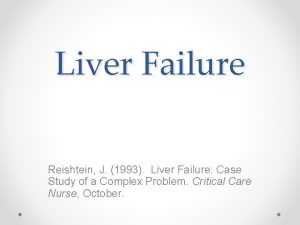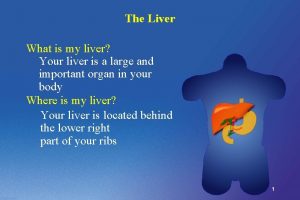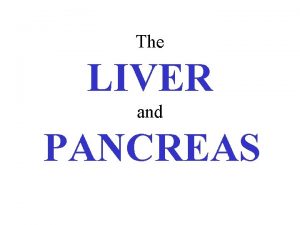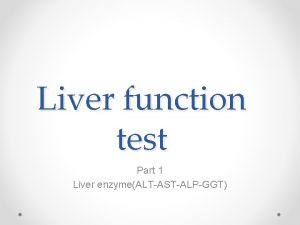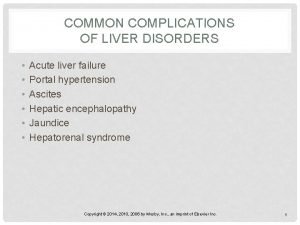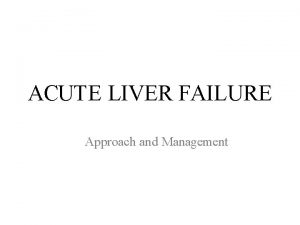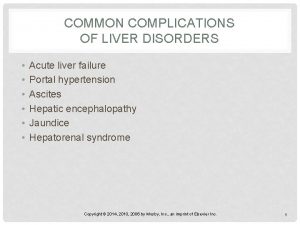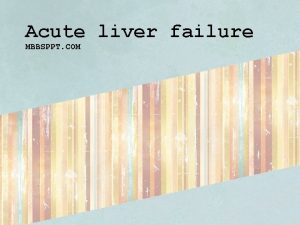Liver Cell Failure LCF Types of liver cell










































- Slides: 42

Liver Cell Failure (LCF)

Types of liver cell failure: 1)Acute. 2)Chronic.

Definition of acute liver cell failure: - It is the clinical syndrome of liver dysfunction, coagulopathy, and encephalopathy developing within 26 weeks of onset of symptoms in patients without pre - existing liver disease.

Classification of acute liver cell failure: - It is based on the time interval between the development of jaundice and encephalopathy. Hyperacute: 0 – 7 days. Acute: 8 – 28 days. Subacute: 29 days – 12 weeks. Fulminant: < 2 weeks. Subfulminant: 2 – 8 weeks. Late-onset: 8 – 24 weeks

Causes of acute liver cell failure: A) Infections: 1) 2) 3) 4) 5) 6) 7) 8) 9) Hepatitis A, B, C, D, E. Herpes simplex virus (HSV). Varicella zoster virus (VZV). Epstein–Barr virus (EBV). Cytomegalovirus (CMV). Transfusion-transmitted virus (TTV). Dengue fever virus. Adenovirus. Parvovirus B 19.

Causes of acute liver cell failure: B) Drugs and toxins: 1) Paracetamol. 2) Carbon tetrachloride. 3) Idiosyncratic drug reactions as INH, phenytoin, valproic acid, sulfonamides, halothane, … 4) Mushroom poisoning. 5) Sea anemone sting.

Causes of acute liver cell failure: C) Ischaemic: 1) 2) 3) 4) Cardiogenic shock. Hypotension as in sepsis. Heat stroke. Cocaine, methamphetamines, ephedrine. D) Vascular: 1) Acute Budd-Chiari syndrome (BCS). 2) Sinusoidal obstruction syndrome (SOS).

Causes of acute liver cell failure: E) Miscellaneous: 1) 2) 3) 4) 5) 6) 7) Wilson’s disease. Acute fatty liver of pregnancy (AFLP). Eclampsia/ HELLP syndrome. Reye’s syndrome. Malignancy. Primary graft non-function after liver transplantation. Autoimmune hepatitis (AIH).

Causes of chronic liver cell failure: (Causes of liver cirrhosis) 1) Chronic viral hepatitis (B, C, D). 2) Alcohol. 3) Non-alcoholic steatohepatitis (NASH). 4) Metabolic: a) Haemochromatosis. b) Wilson’s disease. c) α 1 -antitrypsin deficiency. d) Galactosemia. e) Tyrosinaemia. 5) Primary biliary cirrhosis (PBC).

Causes of chronic liver cell failure: (Causes of liver cirrhosis) 6) Primary sclerosing cholangitis (PSC). 7) Prolonged cholestasis. 8) Hepatic venous outflow block: a) Budd-Chiari syndrome (BCS). b) Heart failure. 9) Autoimmune hepatitis (AIH). 10) Toxins and drugs e. g. methotrexate, amiodarone.

Manifestations of liver cell failure: 1) General health: - Weakness. - Wasting. - Easy fatigability. - Anorexia

Manifestations of liver cell failure: 2) Jaundice: - Parallels the damage and activity of the disease.

Manifestations of liver cell failure: 3) Fever: - Low grade due to: A. Bacteraemia. B. Increased level of cytokines.

Manifestations of liver cell failure: 4) Foetor hepaticus: - Sweetish, slightly fecal smell of the breath. - It complicates severe hepatocellular disease, especially with an extensive collateral circulation. - It is due to methyl mercaptans and ketones in alveolar air.

Manifestations of liver cell failure: 5) Circulatory changes: - There is hyperdynamic circulation. - The COP is increased, PR is decreased with increased blood flow through the skin and spleen. - The hands are warm and sweaty, skin is flushed.

Manifestations of liver cell failure: 5) Circulatory changes: - There is tachycardia, bounding pulse (big pulse pressure), collapsing pulse and capillary pulsations. - In advanced cases of LCF hypotension occurs.

Manifestations of liver cell failure: 6) Skin changes: a) Vascular spiders: - They are found in the vascular territory of the superior vena cava and very rarely below a line joining the nipples. - It consists of central arteriole with numerous small vessels radiating from it, like the legs of spider.

Manifestations of liver cell failure: 6) Skin changes: a) Vascular spiders: - It ranges in size from a pinhead to 0. 5 cm in diameter. When sufficiently large it can be seen or felt to pulsate. Pressure on the central prominence with a pinhead causes blanching of the whole lesion.

Manifestations of liver cell failure: 6) Skin changes: a) Vascular spiders: - They are most common in patients with cirrhosis (especially the alcoholic), may appear transiently in acute viral hepatitis, during pregnancy, rheumatoid arthritis and in normal persons.

Manifestations of liver cell failure: 6) Skin changes: a) Vascular spiders: - In association with vascular spiders, and having a similar distribution, numerous small vessels may be scattered in random fashion through the skin, usually on the upper arms.

Manifestations of liver cell failure: 6) Skin changes: a) Vascular spiders: - These resemble the silk threads in American dollar bills and the condition is called paper money skin.


Manifestations of liver cell failure: 6) Skin changes: b) Palmar erythema: - Caused by cutaneous vasodilatation. - The hands are warm with erythema opposite the head of metacarpal bones, thenar, hypothenar eminences and pulps of the fingers, with central pallor.

Manifestations of liver cell failure: 6) Skin changes: b) Palmar erythema: - The soles of the feet may be similarly affected. - The mottling blanches on pressure and the colour rapidly returns. - The patient may complain of throbbing, tingling palms.

Manifestations of liver cell failure: 6) Skin changes: b) Palmar erythema: - It may be seen in normal persons, prolonged rheumatoid arthritis, thyrotoxicosis, pregnancy, contraceptive pills, use of corticosteroids, chronic febrile illness and leukaemia.


Manifestations of liver cell failure: 6) Skin changes: c) White nails: - They are related to hypoalbuminaemia. - They may be seen in patients with severe liver disease and/or associated malnutrition.


Manifestations of liver cell failure: 7) Endocrinal changes: a) In males: 1) Testicular atrophy. 2) Impotence and decreased libido. 3) Feminine hair distribution. 4) Gynecomastia.

Manifestations of liver cell failure: 7) Endocrinal changes: b) In females: 1) Menstruation is diminished, erratic or absent. 2) Breast atrophy. 3) Infertility.

Manifestations of liver cell failure: 8) Changes in nitrogen metabolism: A) Hypoalbuminaemia: - Due to decreased synthesis by the liver as it’s the only site for albumin production. - Its manifested by: ascites, lower limb edema, white nails, mosaic appearance of the skin and parotid enlargement.

Manifestations of liver cell failure: 8) Changes in nitrogen metabolism: B) Low blood urea level. C) Hyperammonaemia.

Manifestations of liver cell failure: 9) Coagulopathy: - All clotting factors are formed in the liver except von. Willebrand (VW) factor and factor VIII C. - There is prolonged prothrombin time (PT) and decreased prothrombin concentration (PC), not corrected by vitamin K injection.

Manifestations of liver cell failure: 9) Coagulopathy: - The patient may manifest with purpura, ecchymosis or orifical bleeding.

Manifestations of liver cell failure: 10) Hepatic encephalopathy (HE). 11) Ascites. 12) Hepatorenal syndrome (HRS). 13) Hepatopulmonary syndrome (HPS).

Prognosis of liver cell failure: 1) Poor prognosis is associated with a prolonged prothrombin time, marked ascites, gastrointestinal bleeding, advanced age, high daily alcohol consumption, high serum bilirubin and alkaline phosphatase, low albumin values and poor nutrition.

Prognosis of liver cell failure: 2) Modified Child–Turcotte–Pugh (CTP) classification is widely used and proposed to assess survival, and surgical risk.

Modified Child–Turcotte–Pugh (CTP) score:

Prognosis of liver cell failure: 3) The MELD (Model for End-stage Liver Disease) score is a prognostic assessment based on serum bilirubin, serum creatinine, and international normalized ratio (INR); it is currently used transplantation. to determine optimal timing for liver

Treatment of liver cell failure: 1. Good nutrition. 2. Treatment of complications as ascites, SBP, hepatic encephalopathy, variceal bleeding, … 3. Surveillance for HCC. 4. Avoid hepatotoxic drugs, alcohol and treatment of infection. 5. Vaccination against HAV and HBV.

Treatment of liver cell failure: 6. Specific treatment is available in certain instances as HCV, HBV, haemochromatosis, Wilson’s, AIH. 7. Liver transplantation is considered in end stage liver disease.

Thank you
 Child turcotte pugh score
Child turcotte pugh score Ltfai
Ltfai Capture beat
Capture beat Pacer failure to sense
Pacer failure to sense Ductile fracture occurs due to
Ductile fracture occurs due to Portal hypertension definition
Portal hypertension definition Hepatic encephalopathy staging
Hepatic encephalopathy staging Fhf
Fhf Acute liver failure criteria
Acute liver failure criteria Hepatic encephalopathy stages
Hepatic encephalopathy stages Types of failure in distributed database system
Types of failure in distributed database system Allergic granulomatous angiitis
Allergic granulomatous angiitis Types of respiratory failure
Types of respiratory failure Market failures
Market failures Types of market failure
Types of market failure Distortion energy theory problems
Distortion energy theory problems Trachhub
Trachhub Explicit memory
Explicit memory Earthy look in chronic renal failure
Earthy look in chronic renal failure Copd types
Copd types Qms
Qms Example of encoding failure
Example of encoding failure Hershey's erp failure
Hershey's erp failure Failure of supporting utilities and structural collapse
Failure of supporting utilities and structural collapse Failure to thrive definition
Failure to thrive definition Patriot missile failure case study
Patriot missile failure case study Patriot missile failure
Patriot missile failure Lvedp normal range
Lvedp normal range Urinalysis
Urinalysis Advantages and challenges of multigrade teaching
Advantages and challenges of multigrade teaching Example of encoding failure
Example of encoding failure Define market failures
Define market failures The failure of the league of nations.
The failure of the league of nations. Cardiomegay
Cardiomegay Power failure andrew forster
Power failure andrew forster Heart failure definition
Heart failure definition New york scale heart failure
New york scale heart failure Failure
Failure Hide the occurrence of failure from other processes using
Hide the occurrence of failure from other processes using Fatigue marks
Fatigue marks Abyssinia league of nations failure
Abyssinia league of nations failure Iap slides
Iap slides The failure of the league of nations
The failure of the league of nations







